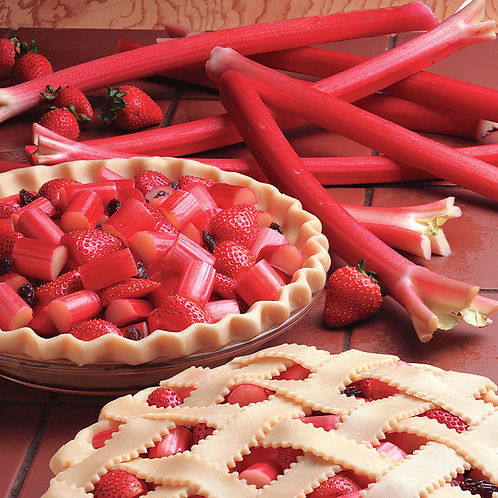




WELCOME TO AN ENTERTAINMENT SITE FOR SCOTTISH COUNTRY DANCERS!
Enjoy this curated selection of theme-related dances for celebrations and holidays, or find a dance associated with a special calendar day, or EVEN your own birthday!
Jun 9

Strawberry Rhubarb Pie Day
The Rhubarb Reel
Other Scottish Country Dances for this Day
Today's Musings, History & Folklore
"Don't fear the rhubarb!"
~ apologies to the Blue Oyster Cult
Loved, hated, or downright feared, rhubarb has long stirred strong opinions. Introduced to Europe in the 1600s, it quickly gained popularity for its striking pink color and distinctively tart flavor—eventually finding sweet harmony when paired with strawberries in the now-iconic strawberry-rhubarb pie.
Despite its culinary charm, rhubarb often comes with a reputation for danger. While it's true that its leaves contain toxic compounds, the crisp stalks are perfectly safe—and even delicious—whether eaten raw, stewed, or baked into pies.
Beyond the garden and the kitchen, the word rhubarb has taken on unexpected lives in language. In theater, it became a kind of spoken filler—stage extras would repeatedly murmur “rhubarb, rhubarb, rhubarb” to mimic the sound of indistinct crowd noise, especially the kind that suggested unrest or grumbling. The same term made its way into baseball slang, where a “rhubarb” can refer to a heated argument on the field.
This delightful 5 couple reel was devised for a generous dancer and gardener who would often gift friends with "crowns" of rhubarb (echoed in the crown triangles) and includes stalk-like chases, and rootball figures (circles)! Not bad for a humble vegetable! Treat yourself to this delicious reel and a slice of strawberry rhubarb pie today! 💚 💗 ❤️ 💚 🥧 🍓 🥬
The Rhubarb Reel
Rhubarb pie and treats have been popular in the UK where it was cultivated since its introduction to Europe from China (attributed to Marco Polo) in the 1600s. The strawberry-rhubarb pie is a favored variation in which the strawberries (and lots of sugar) help balance the natural tartness of the rhubarb.
The genesis of the word “rhubarb” comes from its presence along the banks of the Volga River in Siberia; it is a combination of “Rha” (the Greek word for the Volga) and the word “barbarum,” or barbarian/foreign.
Benjamin Franklin is credited with sending rhubarb seeds to America from England where it became widely cultivated. Rhubarb pie was so popular with pioneer generations that the plant was called "pie plant." The pie figures in sentimental and nostalgic novels taking place from the Civil War through World War II. Although it's botanically a vegetable, it became officially a fruit in the U.S. in 1947, when a New York court reasoned that it was used mostly for desserts, and therefore was a fruit. Everywhere else, it's considered a vegetable. Go figure!
Only the stalks of the rhubarb are used, because Rhubarb leaves contain poisonous substances, including oxalic acid, which is a nephrotoxic and corrosive acid. Frostbitten stalks are also avoided since they maintain toxicity.
The expression "Do you think the rain will hurt the rhubarb?" is a stock phrase used to signify a "deliberate turning to an innocuous topic of conversation (the weather) - when one doesn't wish to comment on a small social outrage deemed to be apparent to anyone of sense."
Interestingly, the word rhubarb itself has been imbued with all sorts of slang meanings, particularly in the world of baseball and in the theater.
The word "rhubarb" is sometimes used by actors to represent the conversation or the noise of a crowd. Supposedly, extras onstage would intone “rhubarb, rhubarb, rhubarb” to simulate muttering, particularly angry muttering.
For the dance cribs and more on the extensive slang meanings of the word "rhubarb," click the vintage can label.
And though everyone has their own favorite, click here for an excellent recipe (using brown sugar and orange juice) with beautiful photographs from Sally's Baking Addiction for a traditional lattice-top version.
Or for a strawberry-rhubarb crostata shown below, click!
Click the dance cribs or description below to link to a printable version of the dance!




